|
Assessing the Vote and the Roots of American
Political Divide
By  - November 6, 2004 - November 6, 2004
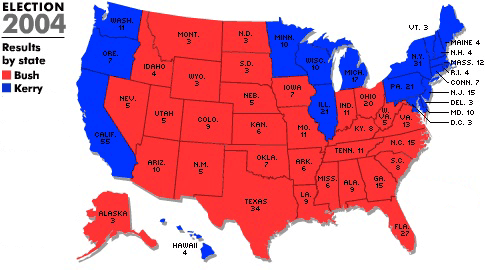
The election of 2004 is an event that will be analyzed and discussed
for a long time to come. What exactly does this election mean, and why
did the nation vote the way that it did?
Making sense of the 2004 election requires an understanding of the
history of American party politics and an understanding the
socioeconomic fundamentals and historical events that have shaped
American society.
Historical Overview of Party Politics in America
Many people in America, especially young people, greatly
misunderstand America's political history.
The Republican Party, over the past 30 years, has adopted the
"conservative" label and has presented their political agenda as
representative of historical values in American society, referring to
the past as the "good ole days" which engenders the idea that whatever
today's Republican positions are, are representative of the way things
used to be. This is why many Americans are surprised to learn that the
wealthy have a lower tax burden today than they have at any time
in American history since the 1920s.
Unfortunately, the American Left has contributed to this
misunderstanding of the past as well because of a type of liberalism
that labels the past as "the bad old days", resulting in a disregard for
the progressive ideology of America's past. Yes, America's political
past is indeed complex, making it difficult to chop into small sound
bites or to explain in schools, but our past is critical in
understanding how America has developed. By demonizing the social
injustices of the past, liberals have also forsaken many of the other
elements of America's liberal past that have helped to make the country
what it is today, such as labor movements, Teddy Roosevelt's trust
busting, Franklin Roosevelt's New Deal, and Lyndon Johnson's Great
Society, as well as the truly critical public discourse and civil study
that took place in America throughout our past.
When looking at our history, what becomes apparent about America is
that social issues have typically driven the American electorate
throughout most of the 20th century. What is interesting and
important to understand, however, is that the social issues have shifted
between the parties, and with that, the socially conservative electorate
has changed economic platforms.
From the Civil War through to today, "social conservatism" has shaped
American politics. The Democratic Party was originally the most socially
conservative party between the Republicans and Democrats. Abraham
Lincoln was the first presidential candidate to run for the newly formed
Republican Party, and he ran on the most socially liberal platform of
the campaign.
While Lincoln did win the election, it is actually due to the fact
that the opposition was split among three other candidates. Four major
candidates ran in the 1860 Presidential Election, two of them Democrats.
All three of the other candidates were more conservative than Lincoln,
but the vote was split among them, resulting in Lincoln, the Northern
liberal, winning the election by winning the free states.

From the time of the Civil War until the 1960s the Republican Party
was seen as a party of the North and the Democratic Party was seen
as a party of the South.
The Democratic Party has historically been a working-class, or common
man's, party. In terms of economic issues the Democratic Party has
historically favored working-class voters, and the Republican Party has
historically favored capitalists and the wealthy.
From the time of the Civil War through the presidency of FDR, the
South was a solidly Democratic region, once referred to by the Democrats
as "The Solid South".
The shift in the South from Democrat to Republican has had major
economic implications for the United States, and understanding why this
shift has taken place is very important.
Blacks got the right to vote in America in 1870, although it remained
difficult for them because of various voting restrictions. At that time
Blacks voted exclusively for the Republican Party because the Republican
Party was the party of Lincoln and it was the liberal party that was
overseeing Reconstruction in the South.
Women did not have the right to vote at this time.
Virtually all white males in the South voted Democrat because the
Democratic Party was the party that represented opposition to many of
the Reconstruction efforts and was fighting to protect white male
interests and traditional Southern culture.
This meant that the Democratic Party, at that time, was both the
culturally conservative party and the party that represented farmers and
working-class interests. However, it was only fighting for white
working-class interests.
The Republican Party was the liberal party that stood for both social
and economic change, i.e. industrialization, liberalism and capitalism.
America is traditionally a farming country. When America was founded
85% of Americans were farmers. After the Civil War, well over half of
the workers in the South were still farmers. The Democratic Party was
the party that represented the interests of rural farming America, while
the Republican Party represented the interests of wealthy industrialists
and urban liberals. Though the Democratic Party was far more popular in
the South, the Democratic Party was considered a worker's party in the
North as well. The Democratic Party championed states' rights and it was
the Republican Party that strengthened the Federal government and
promoted federalism and centralization.
The Democratic Party worked to use federal tax money to redistribute
wealth from the wealthy industrialized North down to the poor states of
the South. Farmers and workers in the South saw the Democratic Party as
a major means to help their weaker economy after the Civil War.
After the Civil War the Democratic Party remained strong in the
South. Between the Civil War and the Great Depression the only
Democratic presidential candidate to get significant support outside of
the South was Woodrow Wilson in 1912 and 1916.
Wilson was emblematic of pre-FDR Democratic politics. Wilson
supported segregation, supported the Ku Klux Klan, and was opposed to
woman's suffrage, but he also supported progressive labor reforms,
tariff revisions and regulations on large corporations. Wilson's
politics are very out of place today, he would be considered a social
conservative and an economic "liberal" (liberal according to today's
redefinition of the word).
In 1920 it was largely the Republican Party, along with the Socialist
Party, that supported women's right to vote. Again, the Republicans
represented the more modern urban areas of the North, where the woman's
suffrage movement was being waged.
The Republican Party dominated the "Roaring 20s". Republicans
presided over the economic boom that saw the Stock Market soar to new
heights and saw the disparity of wealth in America reach its highest
point in history up to that time.
During the 1928 election the South alone voted for Democratic
candidate Al Smith. The Southern vote for Smith was almost entirely
based on tradition. Al Smith was an Irish Catholic from New York and did
not represent Southern interests all that well, however, the South had
never voted anything but Democrat since the Civil War and they stuck
with the party for the election.
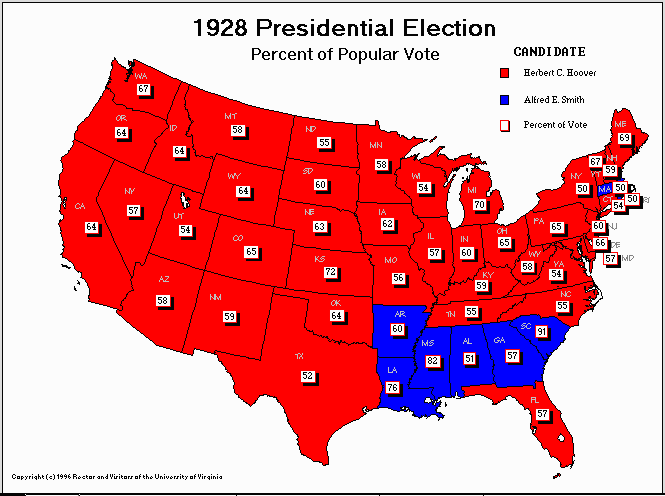
After the Great Depression, the Democratic Party gained more support
than ever before in American history.
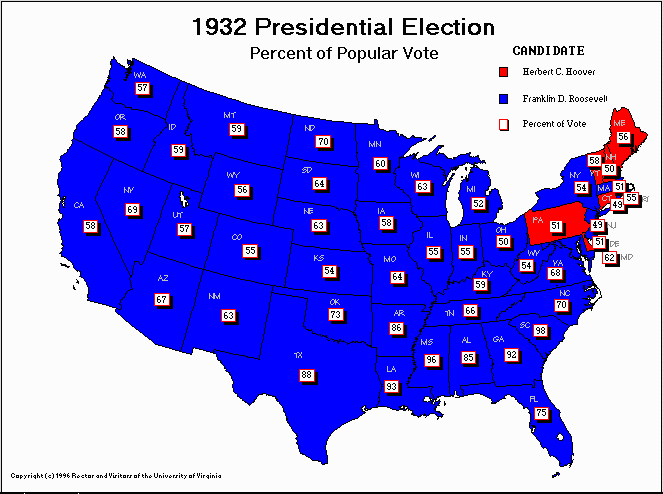
When FDR came into the presidency during the Great Depression major
change in the Democratic Party began.
In 1936 FDR won re-election by the largest margin of any president in
American history with 60.8% of the popular vote and an electoral vote
count of 523-8.
FDR was from New York. He was a modern liberal urbanite. He was a
somewhat different type of Democrat than the traditional Southern
Democrat, although he supported many of the same economic programs that
were popular in the South. Southern Democrats were instrumental in the
development of FDR's New Deal programs.
Although FDR was a social progressive, he knew that he could not
alienate his Democratic base in the South, and thus FDR remained neutral
on the major social issues of his day, women's rights and minority
rights. However, because the Great Depression was so bad, it forced most
people to vote by their wallet instead of by social issues, and thus
many Blacks joined the Democratic Party for the first time, despite
historically being strongly pro-Republican.
While FDR did not directly do much to specifically aid Blacks, he did
not take any actions against Blacks either and he extended the New Deal
benefits to them the same as to whites. In addition, Eleanor Roosevelt,
the First Lady, was the most socially progressive First Lady in American
history up to that time.
This resulted in the beginning of a "social values" shift in the
Democratic Party on a national level.
The Republican Party lost major support during the Great Depression
because there was a backlash against the wealthy and against big
business and corporations.
Throughout FDR's 12 year presidency, however, support for the
Democrat weakened among whites in the South. As this happened the
Republican Party began courting socially conservative voters in the
South in efforts to reconstruct a party base.
Citizens who were Democrats began to feel increasingly betrayed by
their party because FDR was allowing Blacks to advance and was granting
Blacks equal access to his New Deal programs. His Democratic
constituents wrote to him to express their views:
"Any white man who worked for the betterment of negroe races,
the President included, was a traitor."
"Let [the Negro] stay in his place."
"Mr. President, we southern people don't believe in no such
stuff as social equality with the negroes as you are doing."
After World War II was over, Democrat Harry Truman took FDR's
socially liberal legacy a step further.
In 1947 he proclaimed:
"It is my deep conviction that we have reached a turning point
in the long history of our efforts to guarantee a freedom and
equality to all our citizens… And when I say all Americans--I mean
all Americans."
President Truman went on to develop and present a ten-point program
for civil rights. The program included provisions for an anti-lynching
law, an anti-poll tax law, a permanent Fair Employment Practices
Commission, a Commission on Civil Rights, home rule for the District of
Columbia and desegregation of the armed services.
When Truman took these steps, many members of the Democratic Party
felt betrayed and downright sickened. The Democrats of the South felt as
though their party had been taken over by Northern Liberals and was
undermining "Southern values".
At the 1948 Democratic National Convention Herbert Humphrey argued
that the Democratic Party had to abandon the traditional party line of
States Rights on the matter of civil rights, by stating:
"To those who say that this civil rights program is an
infringement on states' rights, I say this, that the time has
arrived in America for the Democratic Party to get out of the
shadows of states' rights and walk forthrightly into the bright
sunshine of human rights."
After the 1948 DNC the Dixicrats, as they are known, were formed. The
Democratic Party was being divided, and a battle for the heart of the
party was under way.
Because of Truman's support for Civil Rights, Democrat Strom Thurmond
ran against Harry Truman in the 1948 presidential campaign on a
segregationist platform that opposed Truman's civil rights agenda. As
shown below, Thurmond garnered support in the Deep South.
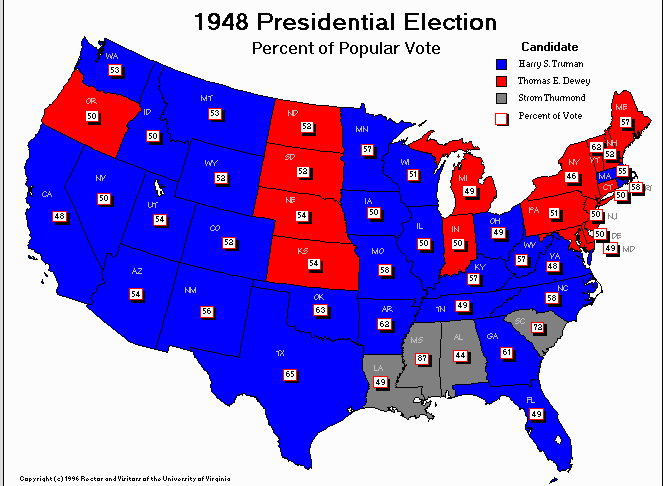
During this whole time, both Liberal Democrats and Dixicrats remained
the representatives of the economic interests of working-class people
and farmers. The fact of the matter is, however, that the majority of
working-class people in the South were, and are, socially conservative.
As a fractured party the Democrats continued on into the 1950s and
1960s.
The Party was able to continue representing working-class interests
because it was really two parties combined. While some social
conservatives defected to the Republicans, many conservative Democrats
continued to support socially conservative Democrats at the local level,
leading to a large number of local and state officials, such as
governors, mayors, congressmen, etc, retaining broad Democratic support
in the South.
During Eisenhower's presidency, working-class support was very much
behind government initiatives and Keynesian economic policy of
government involvement in directing the economy. During the 1940s and
1950s American government programs predominately helped whites. A large
part of government aid programs developed by the Democrats went to
helping farmers and rural areas. Eisenhower himself, despite being a
Republican president, was pro-working class and was in favor of using
federal programs to help support a middle-class.
Eisenhower was in fact a registered Democrat prior to World War II,
and was not an ideological Republican by any means. Eisenhower was not
politically driven. Eisenhower did not intend to run for president after
World War II, but both parties were urging him to run on their ticket.
Eisenhower said that he finally chose to run as a Republican mostly
because the Democratic Party had been in power for so long (19 years).
Throughout his presidency his major focus was foreign affairs, not
domestic policy. In addition, Democrats controlled Congress during most
of his presidency as well. Southern states continued their traditional
voting patterns during both of the elections that Eisenhower ran in,
voting overwhelmingly against the Republican.
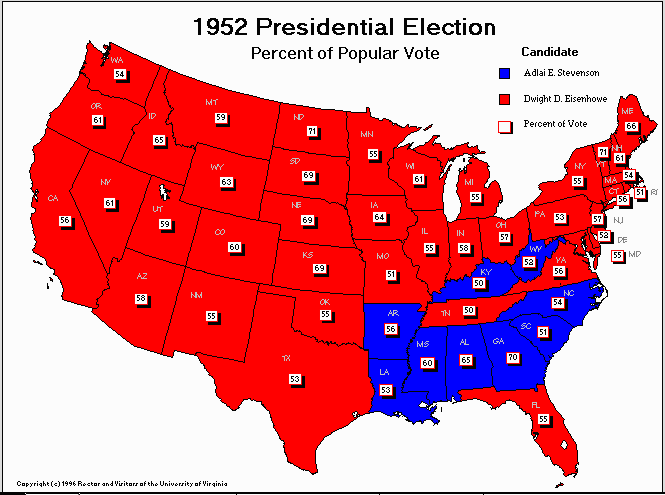
When John F. Kennedy, a Northern Liberal, ran for President in 1960,
he did so with a Southern running mate, Lyndon Johnson. Even with this
Kennedy faced a hard time getting votes in the South as by that time
social conservatives were increasingly wary of Northern Democrats.
Kennedy ran on a platform of international anti-Communism while
protecting American freedoms domestically, and he also appealed strongly
to farmers. He campaigned on "effective government, not big
government".
For example, during his famous televised debates with Richard Nixon
he stated:
The argument has been used against every piece of social
legislation in the last 25 years. The people of the United States
individually could not have developed the Tennessee Valley;
collectively they could have.
A cotton farmer in Georgia, or a peanut farmer or a dairy
farmer in Wisconsin and Minnesota-- he cannot protect himself
against the forces of supply and demand in the marketplace, but
working together in effective governmental programs he can do so....
I don't believe in big government, but I believe in effective
governmental action, and I think that's the only way that the United
States is going to maintain its freedom; it's the only way that
we're going to move ahead.
Despite being from the North, Kennedy was still able to carry most of
the South, relying heavily on traditional Democratic support.
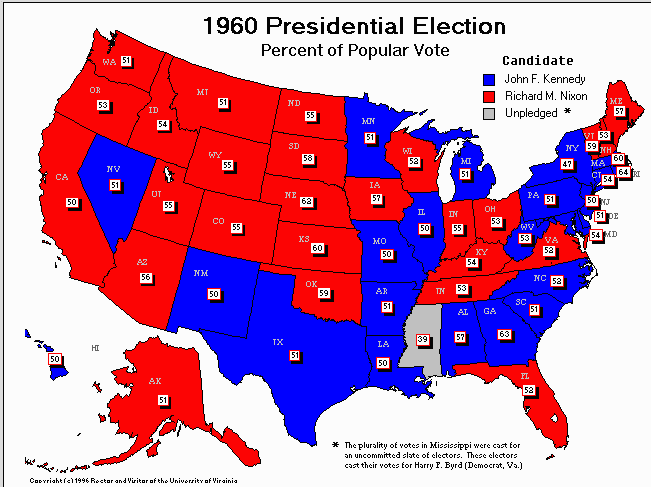
During Kennedy's presidency the civil rights movement was in full
swing and Kennedy gave tacit support to the movement, however he did
move slow on civil rights support out of fear of losing support
from Democrats in the South during his first term in office.
Kennedy, of course, never saw a second term in office, but after his
death Lyndon Johnson did push the Civil Rights Act through congress.
Johnson used Kennedy's death as a moral calling to gain support for the
Act, claiming that the civil rights legislation was part of Kennedy's
legacy and "what he would have wanted". Even with this, the Civil Rights
Act was hard to get passed. Ironically, in an attempt to make the bill
"too extreme", it was expanded by its opponents to include protection
against sexual discrimination as well. It was thought that by adding in
protections for women that the bill would become so liberal that it
would not pass, and at the same time, its opponents could maintain the
moral high ground. Nevertheless, the bill passed and Lyndon Johnson
signed the Act into law.
After doing so he privately stated: "I think we have just
delivered the South to the Republican Party for a long time to come."
Indeed, after signing the Civil Rights Act Johnson lost in the Deep
South by a large margin, though he carried the rest of the country.
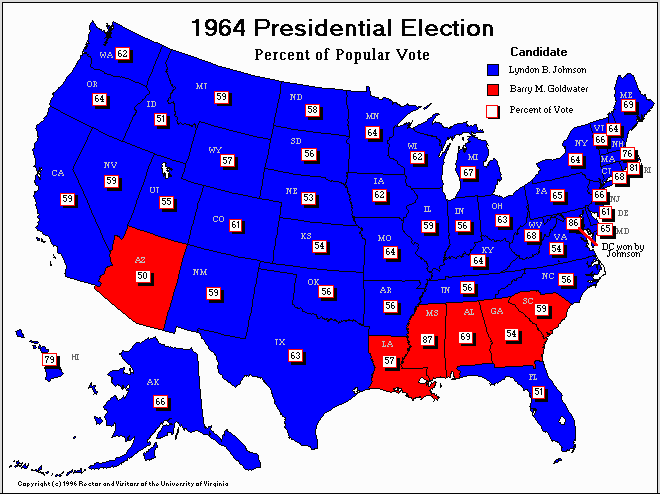
This certainly did open a larger split in the Democratic Party, but
it didn't completely immobilize it just yet. However, as Blacks became
extremely strong supporters of the Democratic Party because of this
legislation, the conservative base for the party continued to
deteriorate and social progressives began to dominate the party.
At the same time, Barry Goldwater, Johnson's 1964 opponent, had run
on an extremely "conservative" platform, arguably the most "far right"
platform that the Republican Party had ever adopted for a presidential
race up to that time. Goldwater also adopted the States Rights agenda of
the old Democrats, bringing that platform over to the Republican Party,
which had traditionally been a federalist party.
The split in the Democratic Party became even more evident in the
1968 election, what was to be the last stand of the Old South Dixicrats.
This highlighted the Northern Liberal vs. Southern Conservative factions
of the party. George Wallace of Alabama ran on a segregationist platform
against fellow Democrat Herbert Humphrey from South Dakota. The
splitting of the vote led to the election of Richard Nixon. After this,
most of the remaining conservative Democrats defected to the Republican
Party.
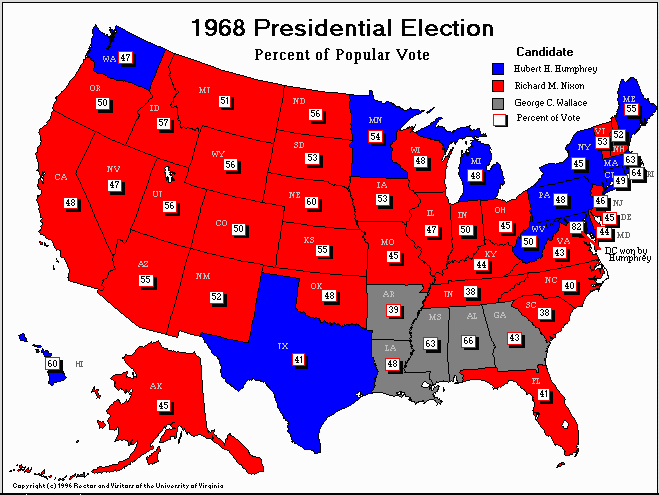
Richard Nixon won one of the most complete victories in American
presidential history in 1972, getting every state except Massachusetts.
He was running for reelection against George McGovern, the most "far
left" Democratic Party presidential candidate in American history.
In 1976, after Nixon had resigned in disgrace because of the
Watergate scandal, Jimmy Carter was able to win both Southern and
Northern states. Carter was from Georgia and was also a vocal
evangelical Christian. In addition to that, much of the reason why
Carter was elected was because of opposition to his opponent Gerald
Ford, Richard Nixon's Vice President, who had pardoned Nixon when he
assumed the presidency.
In 1980 Republican Ronald Reagan, formerly a conservative Democrat,
won 44 of the 50 states. The only Southern state to vote for Jimmy
Carter was his home state of Georgia.
In 1984 Walter Mondale ran on a liberal Democratic Platform, along
with the first female Vice Presidential running mate in American
history. He lost every state except his home state of Minnesota, and
Reagan won by the largest margins in the South and Midwest.
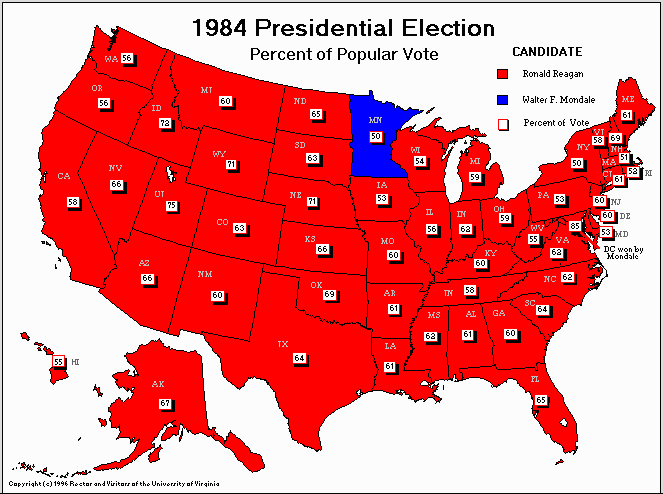
At this point the Democratic Party had firmly adopted a socially
liberal party platform and the remnants of its old conservative Southern
character were almost completely gone. A few conservative Democratic
party members remained, these being mostly older Democrats with
Congressional seats.
By 1988 present day voting trends were beginning to emerge. Michael
Dukakis won only a few Northern states and lost by the largest margins
in the South and Midwest.
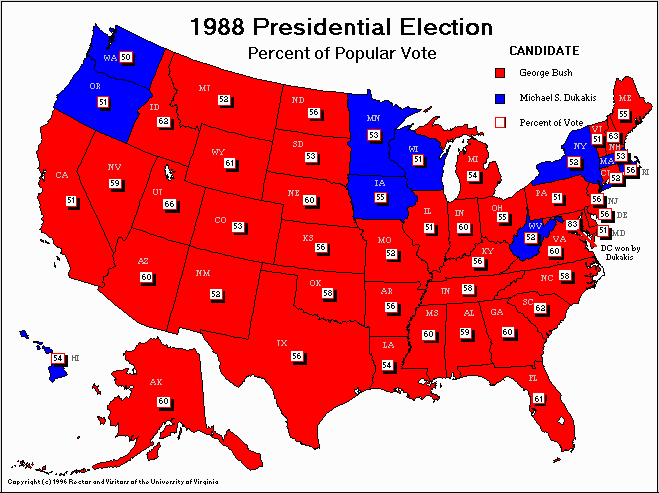
In 1992 and 1996 Bill Clinton was able to win a few states in the
South by adopting a very moderate platform. Clinton abandoned the more
Leftist positions that had been taken by most Democratic Presidential
Candidates from the 1960s through the 1980s. Clinton reduced the size of
the federal government and balanced the budget. He also continued
support for corporate America and presided over the largest increase in
disparity of wealth in America since the 1920s.
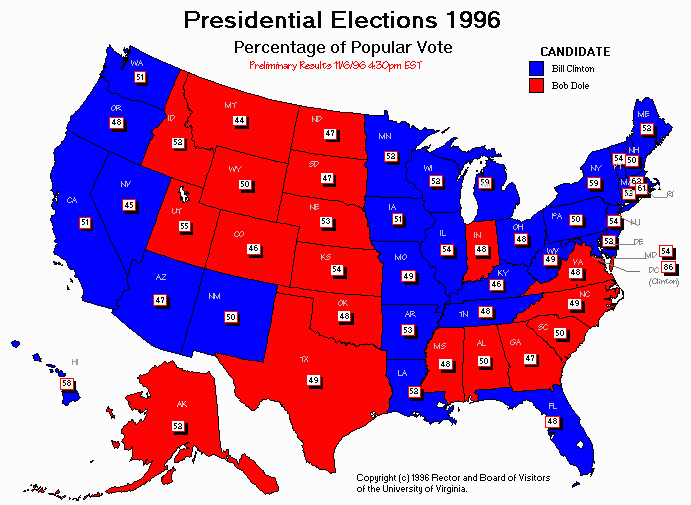
By the time of Bob Dole's 1996 presidential bid, Barry Goldwater, the
Republican that helped to reshape the Republican Party into a
conservative party in 1964, said that the Republican Party had been
taken over by a "bunch of kooks", referring to the Christian
Right. He also told Bob Dole that,
"We're the new liberals of the Republican Party. Can you imagine
that?"
During the 2000 election virtually all of Democratic candidate Al
Gore's support came exclusively from the industrialized and urban areas
of the country, with the exception of a few counties that had high
minority populations.
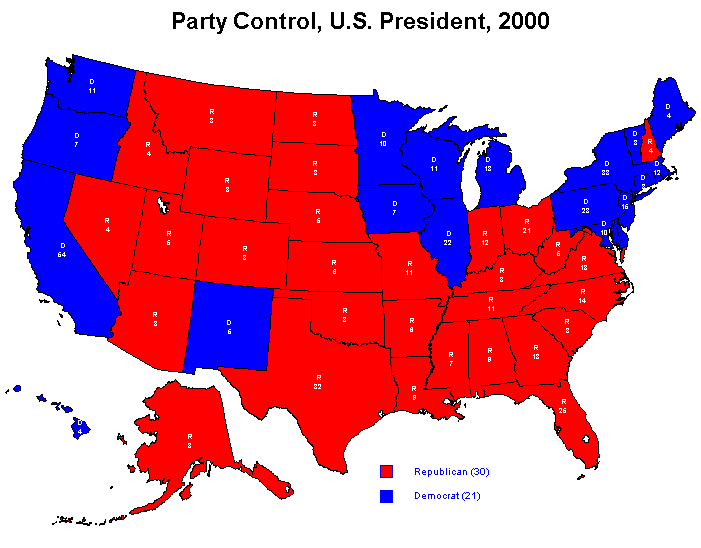
At this point, we need to do a slight review of what has happened.
The Democratic Party, from prior to the Civil War through to present
day, has been the party that has represented, or at least claimed to
represent, the interests of the middle class, farmers and workers.
Southern working-class white males in America have historically been
conservative. This means that when the Democratic Party was socially
conservative it had significant support from working-class white males.
It was working-class white males who supported the New Deal and greatly
influenced the economic direction of America during the 1930-1960s.
During the 1930s through the 1960s American domestic policy was more
heavily controlled by working-class interests than any other time in
American history. This is because white male social conservative support
was behind pro-working-class economic reforms. This was also the time of
highest union membership in American history as well, although unions
were brought under the control of the federal government in 1935 with
the Labor Relations Act. Prior to that time unions were independent
organizations of working men that operated without government controls
or government support.
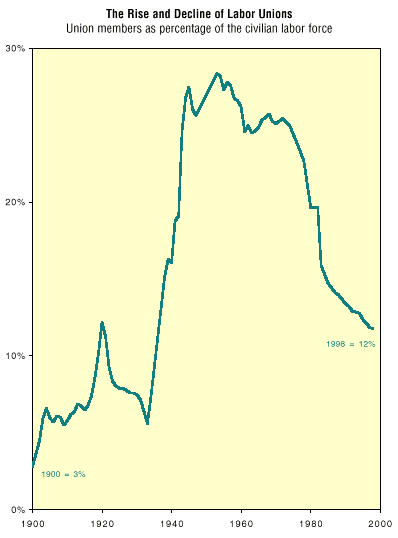
The socially conservative movement was always driven by elements of
the working-class. Once women and minorities joined the ranks of
enfranchised working-class voters, working-class politics in America
adopted a progressive social position.
As that happened, the Republican Party began embracing social
conservatism to pick up votes. When that happened broad conservative
white male working-class support then went to the Republican Party.
The working-class vote has driven American politics since the Great
Depression. The reality is that Southern working-class America is
socially conservative and votes on social issues over economic issues
and always has with the exception of the 1930s during the Great
Depression.
From the time that Lyndon Johnson signed the Civil Rights Act and
initiated his Great Society programs, the South moved away from the
Democratic Party. Despite the fact that the Democratic Party had
traditionally been the party of the South, there was never any
significant Southern support for a Democratic presidential candidate
again after 1964. The only exception to this was in 1976, when Jimmy
Carter swept the Deep South. However, this was due to the fact that he
was from Georgia, he was an evangelical Christian, and Richard Nixon had
just seriously damaged the reputation of the Republican Party.
Because of these factors Carter's support represented an anomaly in
an otherwise steady trend away from Democratic support in the South
because of social conservatism.
What is interesting, is how this has impacted America economically.
The economic positions of the Democratic and Republican parties have
stayed relatively the same over time.
The Republican Party, from an economic perspective, has traditionally
supported economic policy that favors investors, big business and the
wealthy. The Democratic Party has always supported economic policy that
favors farmers and the working-class, at least from the popular
perspective.
Now, within the past 20 years, because the Republican Party has
adopted the social agenda of the old Democratic Party, farmers and
laborers shifted alliances to the Republican Party, especially in the
South. Interestingly, this puts the Republican Party at odds with the
traditional economic positions of its new base. Rural America has been
the recipient of redistributed wealth in America throughout history,
especially since the Civil War. The American Midwest and the South have
traditionally been the largest
opponents to free market practices throughout American history.
A significant element of the Democratic platform throughout history has
been getting federal aid to farmers and using federal funding to
subsidize development in rural America.
This means that the working-class is now divided in America, with a
major segment of the working-class actually voting against their own
economic interests and supporting the investor class, i.e. wealthy
capitalists. Interestingly, while Republican voters are now toeing the
"free market" party line, and have now adopted a mentality that is
opposed to so-called "redistribution of wealth" through taxation, Middle
America remains the largest recipient of redistributed wealth, as has
traditionally been the case in America. This continues to lead to even
more political and economic confusion as "conservative" Republican
voters are led to believe that their wealth is being taxed away to pay
for "liberal programs", when in fact it is the other way around.
The fact is that the "liberal" states are the economic engines of our
country, who subsidize the development of the rest of the country
through federal reallocation of funding from "blue states" to "red
states". Georgia, Indiana and Texas are the only strongly Republican
states (by 2004 election standards) that send more money to the federal
government than they get back in funding. Most of the other red states
receive more money from the government than they contribute. If
"redistribution of wealth" through the federal government were to
actually stop in America, the economies of "red states" would be
severely hurt. This puts Republicans in an awkward position, with
rhetoric that completely goes against the economic needs of their
constituency.
|
States' Balance of Payments with Washington, 2001 (dollars in
millions)
Republican vs. Democratic States During 2004 Presidential
Election
|
| |
Taxes Paid |
Spending Received |
Surplus/Deficit |
| California |
$264,344 |
$206,245 |
-$58,099 |
| New York |
$166,554 |
$126,990 |
-$39,564 |
| Illinois |
$96,686 |
$71,520 |
-$25,166 |
| New Jersey |
$75,115 |
$51,657 |
-$23,458 |
| Texas |
$134,809 |
$121,571 |
-$13,238 |
| Michigan |
$67,886 |
$56,185 |
-$11,701 |
| Massachusetts |
$59,779 |
$48,188 |
-$11,591 |
| Connecticut |
$36,416 |
$25,351 |
-$11,065 |
| Washington |
$49,651 |
$40,233 |
-$9,418 |
| Minnesota |
$36,519 |
$27,384 |
-$9,135 |
| Colorado* |
$33,898 |
$26,618 |
-$7,280 |
| Wisconsin |
$34,609 |
$28,966 |
-$5,643 |
| Nevada* |
$15,014 |
$10,631 |
-$4,383 |
| New Hampshire |
$10,315 |
$7,006 |
-$3,309 |
| Florida* |
$110,294 |
$107,395 |
-$2,899 |
| Ohio* |
$69,127 |
$66,341 |
-$2,786 |
| Indiana |
$36,733 |
$34,630 |
-$2,103 |
| Oregon |
$21,241 |
$19,826 |
-$1,415 |
| Georgia |
$52,225 |
$50,822 |
-$1,403 |
| Delaware |
$5,750 |
$4,632 |
-$1,118 |
| North Carolina |
$47,579 |
$47,748 |
$169 |
| Wyoming |
$3,583 |
$3,824 |
$241 |
| Vermont |
$3,731 |
$3,984 |
$253 |
| Rhode Island |
$6,990 |
$7,458 |
$468 |
| Utah |
$11,358 |
$12,139 |
$781 |
| Nebraska |
$10,415 |
$11,469 |
$1,054 |
| Idaho |
$6,683 |
$7,977 |
$1,294 |
| Kansas |
$16,503 |
$17,806 |
$1,303 |
| Maine |
$6,904 |
$8,643 |
$1,739 |
| Iowa |
$16,725 |
$18,523 |
$1,798 |
| South Dakota |
$4,293 |
$6,095 |
$1,802 |
| Pennsylvania |
$83,052 |
$84,880 |
$1,828 |
| Arizona |
$30,057 |
$32,392 |
$2,335 |
| Alaska |
$4,200 |
$6,685 |
$2,485 |
| Montana |
$4,359 |
$6,910 |
$2,551 |
| North Dakota |
$3,288 |
$6,169 |
$2,881 |
| Hawaii |
$6,903 |
$10,185 |
$3,282 |
| Arkansas |
$12,476 |
$17,469 |
$4,993 |
| South Carolina |
$20,799 |
$26,070 |
$5,271 |
| West Virginia |
$7,793 |
$13,064 |
$5,271 |
| Tennessee |
$33,225 |
$38,986 |
$5,761 |
| Kentucky |
$20,509 |
$27,210 |
$6,701 |
| Oklahoma |
$16,667 |
$23,790 |
$7,123 |
| Missouri |
$33,718 |
$41,452 |
$7,734 |
| Louisiana |
$21,371 |
$29,249 |
$7,878 |
| New Mexico* |
$8,487 |
$17,156 |
$8,669 |
| Mississippi |
$12,094 |
$21,023 |
$8,929 |
| Maryland |
$41,779 |
$50,966 |
$9,187 |
| Alabama |
$22,437 |
$33,205 |
$10,768 |
| Virginia |
$52,858 |
$74,802 |
$21,944 |
| Total Account Balance for Red States |
$85,644,000,000 |
| Total Account Balance for Blue States |
-$193,925,000,000 |
| * Red States won by
only 5% of the vote or less |
Source: New York's
Balance of Payments with Washington
The real impact of the Civil War
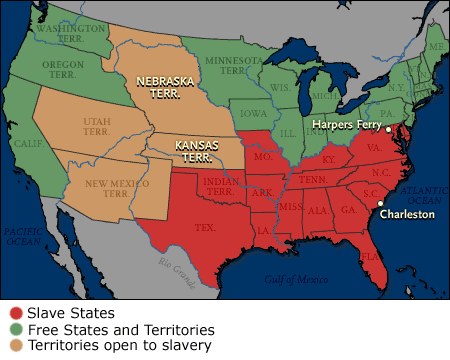
Yes, there is a divide in America today that generally follows the
boundaries of the Confederacy and the Union, however it would be too
simple to assume that this divide is still based purely on the bigotry
and racism of the old South.
Not only was the South a specifically agricultural region, but
because of the two historically different cultures and the Civil War it
made division of America's working-class all the more easy, and it led
to the isolation of the Southern working-class from the historical
development of working-class movements. Not only were Southern workers
isolated from the working-class movements of their time, but there was
no industry in the South worth discussion. Virtually all Southern
economic activity was related to agriculture or merchant activity.
The American South is actually one of the few places in the entire
world that never embraced the working-class ideology of the 19th
and 20th centuries. At a critical time in world history, the
Southern region was isolated from international events and was consumed
with its own regional social conflict. In the American South the "enemy"
of the white male working-class was not wealthy capitalists or corrupt
royalty, but it was instead poor blacks and liberal women.
When one contrasts the events in the social development of regions
around the world during the late 19th
and early 20th centuries, one sees that all across Europe,
Russia, Asia and South America the dominant social struggle of the time
was of the working-class against oppression and wage labor.
The American South did not take part in this struggle. It was instead
fighting a backward struggle apart from the rest of the world. In the
American South the working-class was bitterly divided by race with
working-class whites fighting, not for the improvement of workers'
rights, but instead fighting for the continued oppression of the class
that was below them, the newly freed propertyless slaves.
At the time of the Civil War, the American South was the single
largest slavery system in the world. The other major region of the world
with a large slave system was South America, however, South American
slavery was vastly different than North American slavery. South American
slaves were not recognized as property like slaves in the United States
of America were. Furthermore, in South America there was much less
distinction between slaves and free men, so as slavery ended in South
America slaves became a part of society much more rapidly. The
descendants of slaves more quickly integrated into the working-class and
united in struggle against not only domestic exploitation, but foreign
imperialism as well.
And so, despite the fact that slavery also existed in South America,
it did not result in the same type of fragmentation of the
working-class.
By the end of the 19th century the American South stood
alone in the world as the most backward and divided working-class in the
world. Whereas workers in the rest of the developing world were
directing their attention "up" against exploitation by the wealthy, be
they capitalists, the remnants of royalty, or foreign imperialists, the
workers and farmers in the American South were directing their efforts
"down", seeking to retain their class position above the ex-slaves.
Instead of fighting for their own rights as workers, white males in the
South were fighting to continue to deprive the lower class of their
rights.
Farmers and rural workers around the world tended to join industrial
workers in support of advancing workers' rights as a whole. In this way,
even regions where wage labor had not yet come to dominate society,
agricultural workers and craftsmen joined forces with their fellow urban
laborers to work in their common interest. This is because throughout
the Old World, both peasants and laborers were typically non-propertied,
and thus had a common cause.
However, because of the rifts between the industrial North and
agricultural South in the United States, this cooperation never took
place, and in fact these two interests opposed each other and have
continued to oppose each other ever since.
Water doesn't turn states blue, capitalism does
While many have commented that it must be the water on the coasts
that is "turning the states blue", the reality of why these states are
"Democratic states" today is much more sophisticated than that. One of
the major reasons why these states, the so-called blue states, lean
left, and thus vote Democratic, is because these are the states that
feel the greatest impact of capitalist culture.
Economic leftism is a reaction to capitalism, and liberalism is a
product of capitalist society.
"Blue regions" in the United States are overwhelmingly the most
economically developed regions. These are the regions where capitalism
is the most developed and capitalist society has the most direct impact
on people's lives.
While "capitalism" is the almost religiously worshiped economic
system of the entire nation, the Midwest and Southern regions of the
country really have not experienced capitalist society until recently.
The "red" regions of the country have lived a much more "communal"
lifestyle, where the natural socially fragmenting effects of capitalism
have not historically impacted life the way that they have impacted the
lives of people in industrialized and urban areas.
An excerpt from a local south Florida newspaper article demonstrates
this point:
He said life in a Florida fishing town as recently as 30 years ago
was a close-knit affair, families often gathering for oyster roasts
and clambakes at fishhouses.
"I have to laugh - I look at your Community Happenings calendar and
there must be hundreds of support groups," Sembler said. "We
didn't have that then. When people got sick, somebody from down the
street would help them."
Out on the water, he said, younger fishermen helped old men haul
nets fouled by sea weed and kept an eye on them.
Old Florida wasn't pretty to some people - wooden houses often
needed painting, lobster traps were piled next to old pickup trucks.
"There were no Key West pastel colors," Sembler said. "It was white
or it was gray - and that was it."
During the 1990s, his hometown adopted an "Old Florida Fishing
Village" architectural theme for its riverfront district in a bid to
make it attractive to tourists and newcomers.
This doesn't ring true with Sembler.
"I can't remember anywhere in our old Florida fishing
village where you could go down and buy a colorful drink with a
little umbrella in it," he said.
What we are seeing in America is two very separate stages of
development of political economy in an environment where the development
of political and social consciousness has been greatly altered from its
natural course by historical events, these events being the Civil War
and the Cold War.
The South and the Midwest have been relatively strongly shielded from
the negative social effects of industrialization and the development of
capitalist society. Up until very recently, perhaps the past 10 to 15
years, the economy of the red states was largely based on farming and
small business. These people were not experiencing capitalism. Large
populations of wage laborers are not a common part of the makeup of red
state demographics, and in the cities and urbanized areas of "red
states" you do see much stronger "blue" support.
What the "red states" today are experiencing is the spread of
capitalist society into their regions. Many people misunderstand what
capitalism is in America, and this is largely because of the Cold War
and the propagandistic approach to economic understanding that took
place in America between the 1940s and the 1990s.
During the Cold War "anti-Communism" became a major sociopolitical
force across the Midwest and the South. It was easy to demonize the Left
and to glorify capitalism in these regions because the people living in
these regions had no real contact with capitalism.
It was easy to use anti-Communism to demonize all elements of the
Left in the South and Midwest because these people had very little first
hand contact with either Marxist ideas or with capitalism itself, and
thus those who framed the discussion were able to shape perceptions
about things that people had no first hand knowledge of.
It was easy to demonize unions in the South and Midwest because so
few people in these places had contact with either unions or with the
working conditions that spawned union activity. All of these reasons
made the South and Midwest attractive areas for the Republican Party to
look for support.
In the South and Midwest people were farmers, people owned their own
land, they owned their own businesses, they had an established community
of friends and neighbors. They did not face the harsh reality of urban
and mechanized life. They did not face living in places where home
ownership was next to impossible, where the majority of people worked on
assembly lines for wages that were dictated by millionaires, deprived of
their self respect and sense of individual purpose.
This is industrial capitalism. This is what the people in the "blue
states" have faced for 100 years in America, and this is the environment
that "blue state" society has developed in.
To a man on his farm, getting up at 4:30 a.m. to say his prayers and
go out into his barn to prepare his tractor and seed for the day, coming
back inside at 6:00 to eat the fresh cooked breakfast that his loving
wife has made for him, and then going out to work the fields with his
son until 6:00 p.m., its very hard to understand the sentiment of a
thousand angry workers, striking out in front of a Ford auto plant,
demanding more pay and shorter hours.
The farmer sees his trusty Ford truck, a truck that he depends on for
his livelihood, and he gets angry at those union men for refusing to
work and demanding more pay. He gets up before dawn and works hard all
day long, loves his wife, prays to God to thank him for everything that
he has, and loves his country, and now these men are "going to make the
cost of a new Ford truck go up" because "they" want more pay?
It was easy for the Right to turn that anger and misunderstanding
against fellow Americans and against their economic opponents: wage
laborers.
The difference, though, is that rural citizens had control over their
own lives. They owned a lot of property, and that property was important
to them. They owned land, they owned tools, they owned supplies, they
owned and operated their own stores and businesses.
And so, this is what has happened, politicians have turned Americans
from vastly different cultural experiences against each other. Those
that represent the interests of the wealthy capitalist class have used
rural and suburban America to undermine the interests of working-class
wage laborers.
Large corporations have used small businessmen, farmers and the
self-employed to protect their own interests. They appeal to these
groups and tell them that that are "among the capitalist class", when in
fact they are not. But they have connected with Middle America and
convinced them that the interests of industrialized corporate America
are the same as the interests of small town America. Since Middle
America does not experience life in the urban industrial centers they
don't see the difference between industrial capitalism and independent
rural America.
Corporate America and the Right feed Middle America's fear of the
urban working-class, using this fear as a political bulwark against the
interests of wage labor.
Middle America has traditionally reaped the fruits of capitalist
production without having to endure the reality of capitalist society.
Industrialized areas have produced goods that are made available in
rural and suburban America, which has allowed these regions to benefit
from mass production and wage labor capitalism without living in the
environment created by mechanized wage labor society. Middle Americas
have had a very distorted perception of capitalism because they have
only been on the receiving end of the capitalist system, and have not
themselves lived in capitalist society.
The irony here is that what Middle America is now experiencing is the
encroachment of capitalist culture into their traditionally rural and
independent region.
Over the past 20 years wage labor society has spread into Middle
America and the South. What is the vehicle of this encroachment? It is
the increase and aggressiveness of marketing, the increase of liberal
entertainment, and, most importantly, the growth of wage labor in rural
America.
The first of these items is self-explanatory, however understanding
the increase of liberal entertainment is slightly more complex. Liberal
post-modern society is a product of urban capitalist socioeconomic
relations.
Urban and rural society have always been different, even prior to the
development of capitalism. However, they are more different today than
ever. Additionally, in the past these two cultures did not mix and
impose themselves upon each other the way that cultures mix today via
the mass media. Because most media in America is a product of urban
post-modern culture, it does not represent the values and interests of
Middle America. "Red state" values have traditionally been based on
community, a relatively humble existence, and a culture of opposition to
worldly desires. Capitalist culture, however, promotes a culture of
selfishness, neediness, and putting individual desire above community
interests. Capitalism intentionally promotes desire. The basis of
post-modern capitalism is the creation, manipulation, and deepening of
human desire. Capitalism, not just through marketing, but all aspects of
capitalist society, encourages self-indulgence and lasciviousness.
Desire creates demand, and demand "moves product".
The intrusion of liberal capitalist society into rural America's
community based social structure it not the only problem that Middle
America is facing however.
With the explosion of large chain retail stores, chain restaurants,
and factory farming, wage labor is now becoming increasingly prominent
in "red" America. White rural America has historically been a relatively
classless society where individuals have independently owned and
controlled their own economic means. With the advance of wage labor into
Middle American society, rural Americans are now experiencing the
beginnings of the capitalization of their culture.
The problem is, though, that Middle America is now completely out of
step with the historical development of the labor movement.
Middle America has been used to bludgeon the American labor movement
to death, and now that rural Americans are in the process of being taken
over by the capitalism that they have been supporting from afar for so
long, they don't have the class-consciousness or critical questioning of
the system that is needed to combat its harmful effects.
Middle America has experienced nothing but the blessings of
capitalism for the past 50 years, while remaining able to preserve their
pre-capitalist, independent society. Now, however, traditional society
is finally being imposed upon by wage labor, large corporations,
international business, post-modernist media, apartments and housing
projects, and these people are feeling the stress and despair of
capitalist social disruption. But, because of 50 years of Cold War
propaganda, because of the American glorification of capitalism,
because, it is claimed, capitalism has "saved God" by defeating the
Soviets, the real cause of the despair and turmoil within Middle
American society goes unrecognized by the Southern and Midwestern
working-class.
"Red state" America is facing a real social crisis. That crisis is
the struggle against the social changes that come with the loss of
economic independence caused by the takeover of capitalist wage labor
society.
Because, however, "red state" America has no ties to historical labor
movements, and in fact has a history of opposition to the great labor
movements of Western Civilization, the way that Middle America is
dealing with the uncertainty and social change that is brought on by
capitalism is by seeking comfort in religion and conservatism.
Summary
The American South is the single largest region in the world that
stood outside the important labor movements of the 19th and
20th century. Not only was the American South not involved in
what was the most important social development in Western civilization
over the past 150 years, but the Southern working-class actually became
a political force used against larger working-class interests, not just
within the United States, but globally.
What we see today as "red" America are the unindustrialized regions
that have not experienced true capitalist society and have much less
experience with wage labor.
Because of the Cold War, objective analysis of political economy in
the United States has been effectively stifled since World War II. Now,
as capitalism and wage labor advance across Middle America for the first
time, Middle American society is not in a position to understand and
deal with the real causes of social change and fragmentation.
Furthermore, because the Republican Party has portrayed itself as the
party of "conservative" values over the past 40 years, which are the
values of the Middle American working-class, the Republican Party has
consolidated a large portion of American working-class support.
The Republican Party, however, ultimately acts in the interests of
the wealthy elite and corporations. Conservatism has enabled the
Republican Party to not only get much broader support than it would
otherwise be able to do based on its economic platform alone, but it has
in fact enabled the Republican Party to reshape class consciousness in
America and define working-class interests for the working class.
This has enabled the most exploitive institutions of American society
to dictate to the working-class and to mold the economic views of
extremely large portions of working-class America. This is why large
portions of the American population have continued to vote against their
own economic interests over the past 20 years, and why American politics
is taking such a dramatic turn to the Right. Not only are these people
voting against their economic interests, however, they are also voting
against their own social interests because it is the economic change
that is really bringing about the social changes in their community.
The United States of America now stands as the largest opponent to
working-class interests in the world, with a large base of support from
its own working-class population.
By polarizing the electorate, what George Bush and the Republican
party have done is highlight the substantial differences between
post-modern wage labor society and rural and suburban society that is
currently in the process of struggling to deal with the spread of
capitalist socioeconomic relations into their once pre-capitalist
society. It is not the American Left that represents a threat to the
property and livelihoods of "red state" America, but rather it is
corporate capitalism.
Ironically, the Republican Party is the party that is facilitating
the transformation of once rural and independent Middle America into a
wage labor society where citizens will lose control over their lives and
will experience the breakup of traditional social relations by
capitalist culture.
|